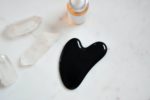About Parabens
Finding Your Personal Balance with Parabens.
Wasn’t life a little easier when we didn’t know about the possible dangers of ingredients that were designed to protect us?
Take parabens. These synthetic preservatives are found in eighty-five percent of cosmetics and many foods and beverages. But as science makes progress and our knowledge of parabens becomes wider, some of what we’re learning is troubling. While it would be easier not to know, being an informed consumer means taking research findings into account for our own personal choices.
In my role as an esthetician, parabens are probably the most asked about ingredient. Clients want to know if they should avoid them entirely or if the risks are being overplayed.
Let’s start with what we know for sure about parabens.
While parabens do exist in nature (including blueberries!), the ones in cosmetics are man-made.
The four most common in cosmetics and skin care products are: butylparaben, methylparaben, propylparaben and ethylparaben.
Parabens’ main benefit is that they kill bacteria in water-based solutions and control the growth of microbes in cosmetics, which would otherwise thrive at room temperature. These qualities can extend a product’s shelf life from about six months to up to two years.
But as with many chemical additives, there are health-related concerns too. Research shows that synthetic parabens stay in our bodies and that women have higher levels. This is presumably because we use more cosmetics then men. This matters, because studies have found parabens in the tumors of women diagnosed with breast cancer. And there’s evidence that parabens may disrupt hormone function by mimicking natural estrogen in our bodies — what’s called an “estrogenic” effect.
Along with these pros and cons, consider one more step before choosing your personal paraben path. Take a look at the FDA’s four “grey areas” for regulating cosmetic paraben use.
- In a skin care product’s ingredient’s list, federal law allows companies to omit any components added to a perfume ingredient. They also do not have to list all chemical ingredients in their label.
- Cosmetic manufacturers may use any ingredient they choose, except for ingredients that are prohibited by FDA regulation. The FDA does not have to authorize cosmetic ingredients except for color additives.
- Companies may claim to be “paraben-free,” but use other preservatives that have not yet been studied.
- Products labeled “natural” or “organic” may still contain synthetic chemicals.
With all this information in mind, here’s how I found my own paraben balance. I choose some products for my natural side and some for the positive effects of man-made ingredients:
- I tend to choose body lotions that are completely paraben-free because I use them lavishly all over my body.
- I have dry skin, so I look for oil-based moisturizing products that don’t need the same amount of preservatives as water-based products.
- When choosing paraben-free products, I look for dark packaging that helps minimize light exposure and reduce bacterial growth—thus extending the product’s shelf life.
- On the pro-paraben side, I’m a big fan of serums because the active ingredients in them are some of the best anti-aging treatments out there. Since these are usually water soluble, they need some sort of preservative in them. In this case, the amount of serum used is tiny, and I feel the benefits are tremendous.
Now it’s your turn to find your personal paraben balance. I encourage you to do some research, ask questions and come to your own conclusions. And please remember that because parabens are used in many products, cosmetics are just one possible source of parabens in our bodies. What’s right for you will be as personal as your own beauty.






